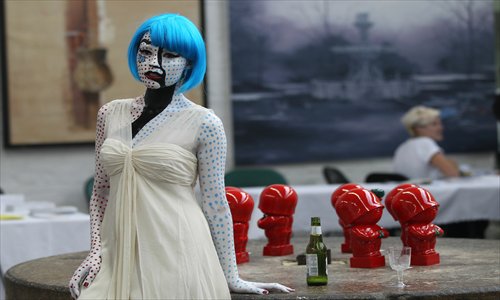Affordable artworks

Art 'supermarkets' revolutionizing market
With the impending autumn auction season coming up, the sky-high price of artworks is again a topic. China's art market has been booming in recent years, with art selling at record-breaking prices.
As auctions are an exclusive playing field for the super rich, many people do not have the means to participate. But the situation is changing, as new options are developing.
An increasing number of artists, art festivals and art "supermarkets" are advocating affordable prices, making art accessible for everyone. As expected, this new platform of purchasing comes with difficulties.
Changing definitions
Parity Arts Festival, a big trade event for art in Xi'an, Shannxi Province, promotes affordable prices. The fair, which started on September 6, admits only original works and selects young and middle-aged artists of potential.
"I Can Pay," an Art Festival that kicked off at Beijing's Times Museum last month is another effort to draw in ordinary consumers. The festival boasts over 500 pieces of art, with prices ranging from several hundreds yuan to 50,000 yuan ($7,890).
The 7th Affordable Art Beijing (AAB), held at 798 Art Zone in June, also featured emerging artists selling reasonable priced art, increasing accessibility to people of different classes. These events all aim to expand the outreach of a prosperous art market that has tapped into the billions.
Tom Pattinson, the founder of AAB, told Artspy, a portal website for art, that AAB capped prices at $5,000, to make the market accessible for everyone, promoting obscure artists while making it possible for people to obtain contemporary art.
Affordable art is now a popular concept. Since 2009, a number of so-called art "supermarkets" have emerged in China, distinguishing themselves from high-end galleries and auction houses with low prices.
Shenzhen's 365 Art Life Supermarket, Shanghai's Zendai Art Supermarket and Chengdu's Xicun Art Space are all examples of popular art "supermarkets."
Li Xianting, an artist revered as the godfather of Chinese contemporary art, has been advocating affordable art since 2005. He said that art should welcome the public.
"People should have ways to purchase original art in a manner similar to shopping for groceries at the supermarket," he told Collection Trend magazine.
According to Li, affordable art will encourage sales and appreciation, generating a new standard of evaluation. "A pyramid foundation will take shape, on top of it will lie great artists."
Win-win situation
Many online shops and platforms are joining the new market.
"Galleries accept a limited number of artists. Online platforms have a huge advantage in promoting young artists," said He Bin, CEO of Hihey.com, an online art market, in an interview on Sina Weibo.
It's difficult for budding artist to enter high-end galleries. Meanwhile, many art enthusiasts cannot find an affordable place to buy art. Online markets and supermarkets provide solutions for both artists and collectors. Artists who previously could not sell can now make substantial revenues through online platforms.
Patrons of art supermarkets mostly buy art for home decoration rather than for investment. Meanwhile, a growing class of white-collar workers, and members of the rising middle class are beginning to collect.
He Bin told the Beijing News that the majority of Hihey's patrons have an annual income above 300,000 yuan.
Most Hihey.com buyers are relatively young and of huge potential, with a majority born in the 1970s.
Some find the possibility of buying a piece of art by an artist who later rises to fame exciting. As Yang Jiawei, a Hihey customer, told the Beijing News, "It is like investing in a start-up company, full of uncertainties and possibilities."
Finding support
Though affordable art is a developing concept in the West, it is still in its infantile stages in China. The supermarkets in this country are still in the process of positioning themselves in the art market.
In 2011, 365 Art Life Supermarket transitioned to selling art reproductions, after going through a slump. Despite initial success, sales of original artworks began to decline. Other similar platforms share the same fate.
An employee at 365 Art Life Supermarket, surnamed Chen, told the Global Times that the site has entered a flat period. Aside from routine sales of original art, 365 Art Life Supermarket takes commercial orders for gifts, which use licensed artworks to make profit.
Despite original art lowering its price, sales are small. Art is not part of the daily expenditure items, and there is an overall lack of patrons. Zhu Jingyi, then the general manager of Zendai Art Supermarket, told China Culture Daily that for most Chinese people, art is not a necessity in life.
"They'd rather buy a sofa than a painting for the same price," Zhu said.
Ji Peng, an independent curator, thinks a target consumer group needs more time to develop. But he is optimistic that original art will make it into every household,
"Ninety percent of families cannot own original art due to prices, but there is a huge demand," he told China Culture Daily. "If art supermarkets manage to sell artworks, it will benefit the entire industry."
Some insiders call for policy support. "Art supermarkets are relatively new, which makes investors cautious about putting their money in," said Huang Long from 365 Life Art Supermarket. "Lack of specific policy support also slows the development of the new mode."
Global Times